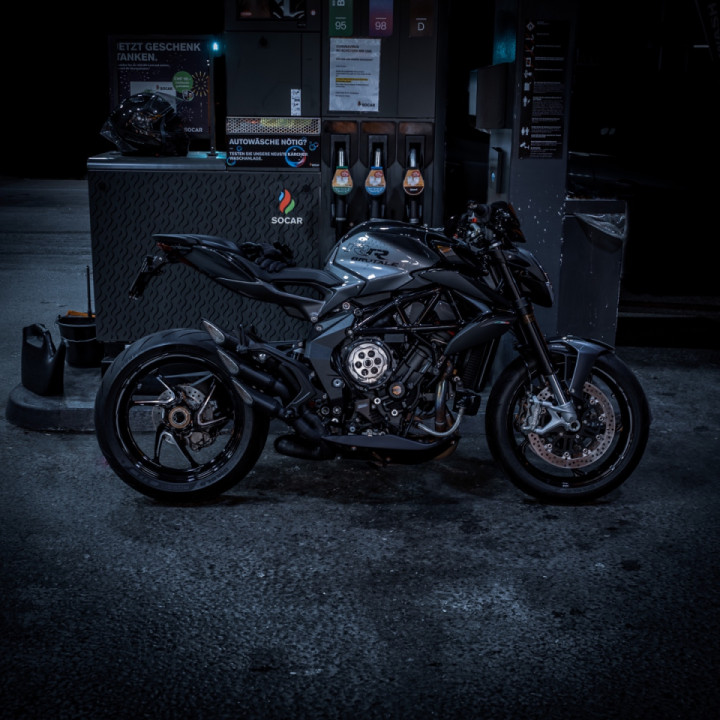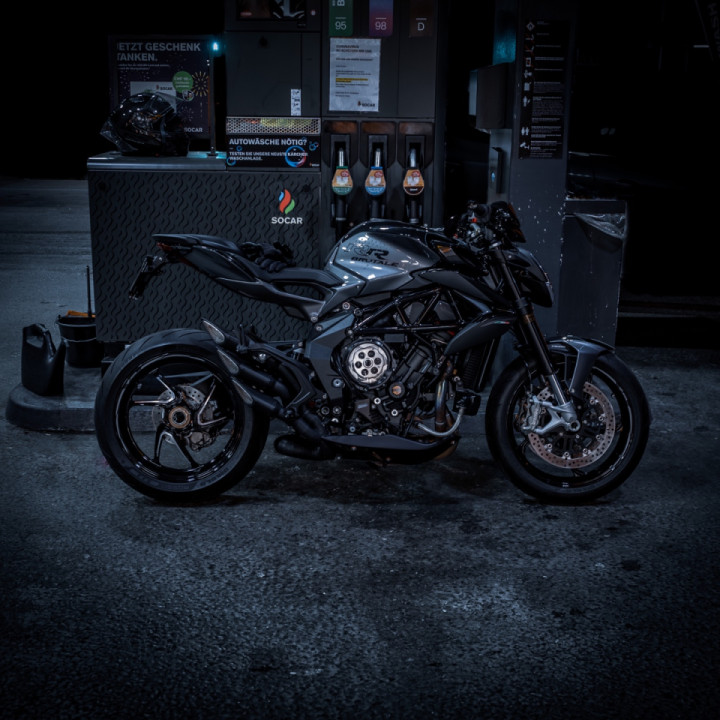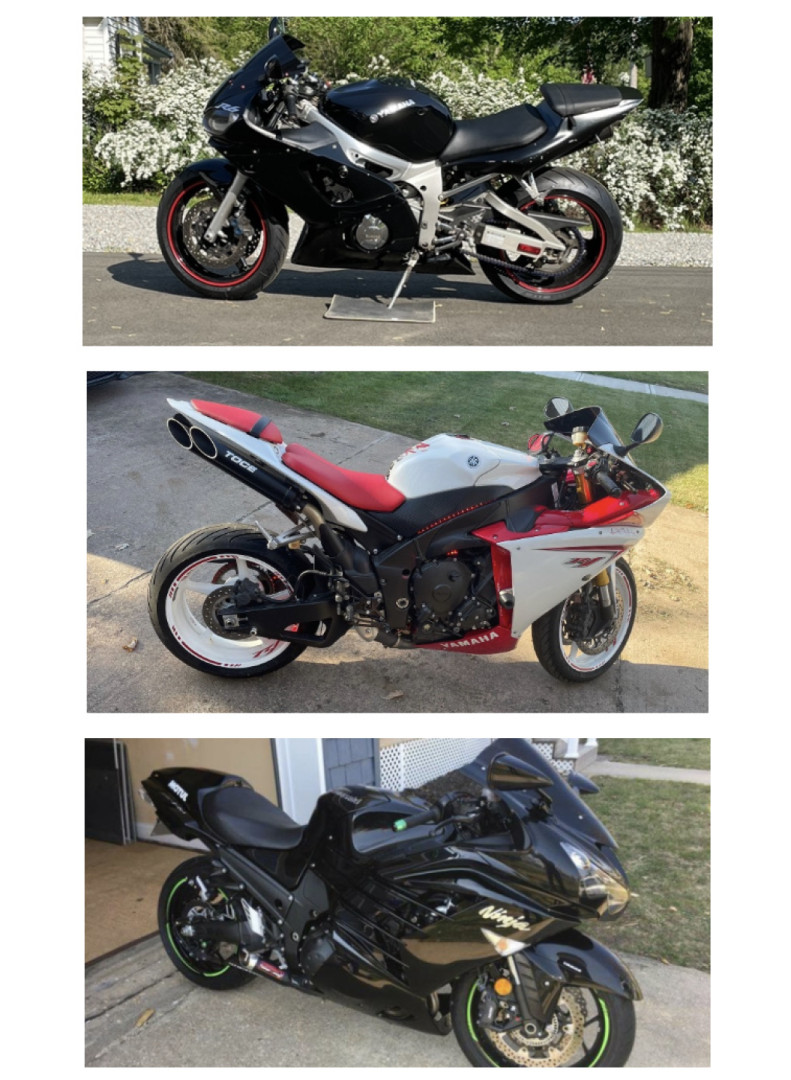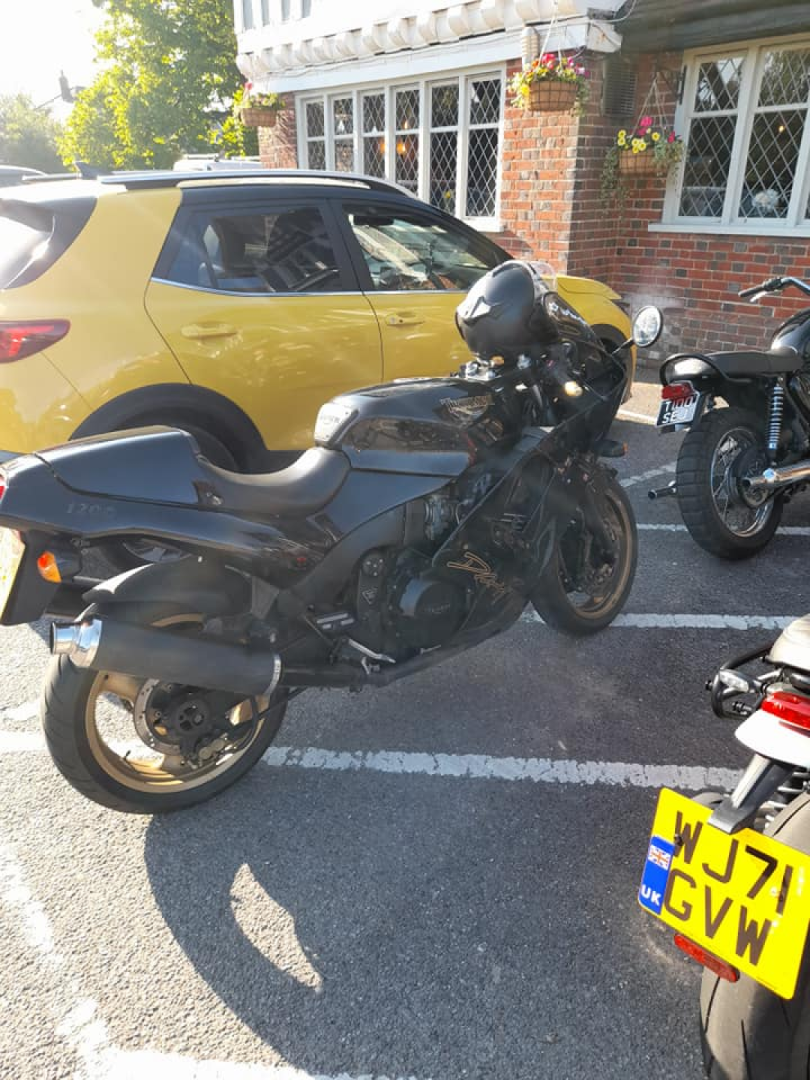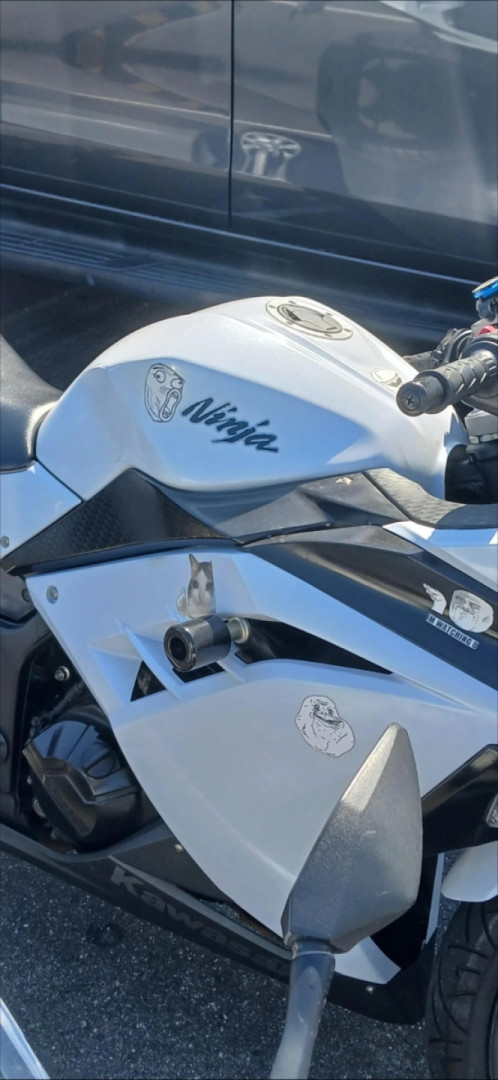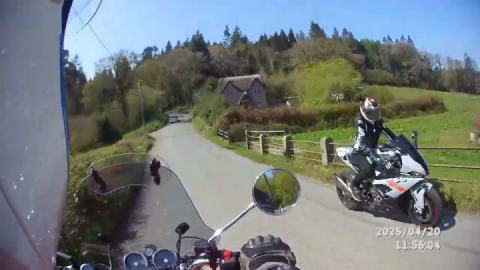Absolutely the most detailed description of the K1200S I've come across...
1. Overall Concept and Model Features
Introducing the K 1200 S, Europe’s largest and most successful manufacturer of motorcycles is enlarging its model range and is entering the supreme class of sporting high-performance motorcycles so far dominated by Japanese manufacturers.
A thrilling synthesis of high performance, precision, riding pleasure, and safety.
Conceived consistently as a sports machine right from the start, the K 1200 S is an absolutely unique and independent motorcycle within the K-family – it is radically new and innovative in every respect. Indeed, the K 1200 S has no predecessor within the BMW Motorrad model range and follows no role model. On the contrary – unique and independent in every respect, the K 1200 S has everything BMW sees in a sports motorcycle: supreme riding precision and agility, engine output and road performance leaving nothing to be desired, as well as safe and superior handling in every situation.
The K 1200 S does not call for any compromises. Instead, it combines all the features previously regarded as largely incompatible: sporting performance and dynamism combined with comfort, playful and easy handling in conjunction with supreme riding stability, high performance coupled with everyday riding qualities, a slender and sporting appearance combined with efficient protection from wind and weather as well as superior ergonomics.
At the same time the K 1200 S comes with all the virtues so typical of all BMW motorcycles – but enhanced in this case to an even higher standard: The new machine is fully suited for riding with a passenger and covering long distances, it offers a long service life, keeps maintenance to a minimum, complies in full with environmental requirements thanks to highly advanced emission management complete with a fully controlled three-way catalytic converter, and offers active safety of the highest standard when applying the brakes ensured by the most advanced brake system in the market: BMW Motorrad Integral ABS.
The K 1200 S is the only sports motorcycle in this segment of the market to feature maintenance-free shaft drive. In conjunction with the Paralever swinging arm developed to an even higher standard and reduced in weight, the drive shaft has been optimised to an even higher standard than before, making its higher level of unsprung masses virtually imperceptible even when the rider chooses a very sporting style of riding.
Featuring innovative top-of-the-range technology and the best riding characteristics in the upmarket sports segment, the K 1200 S rightly claims absolute leadership in its class. So there can be no doubt about it: This new motorcycle will open up new customer potentials for BMW Motorrad.
Unique concept for ideal riding dynamics and ergonomics.
The first point in the approximately five-year development period leading from the initial idea all the way to production maturity was to carefully consider the overall concept in terms of the drivetrain, the configuration and arrangement of the engine, as well as the overall package. And in the process it soon became clear that the advantage of a low centre of gravity so typical of all flat-twin and existing K-models naturally had to be retained on the new motorcycle. Studies and fundamental examinations with the focus on different engine concepts confirmed that from the perspective of power, weight and space requirements, a four-cylinder power unit fitted crosswise was certainly the optimum solution for a high-performance motorcycle of this calibre.
The only drawback with this configuration was the high centre of gravity. But tilting the cylinder bank forward by an extreme 55° and fitting the engine at a very low point, BMW’s motorcycle engineers were able to overcome this disadvantage. Since, in addition, the entire engine block is very slender, this configuration also ensures adequate freedom in bends, allowing the rider to lean over sideways to a low angle.
Together with the extra-low, V-shaped radiator, this configuration, interacting with the wheel suspension and guidance units, allows ideal curvature of the frame above the cylinder head and keeps the entire motorcycle slim and slender. With the frame profiles running closely together at the rear, in turn, the new K 1200 S also enables the rider to keep his knees tightly wrapped around the machine.
The overall result of this intelligent package is optimum geometric configuration of the motorcycle in terms of both riding dynamics and ergonomics. The perfect seating position is tailored to the rider in every respect, giving him – or her – an active riding posture with clear orientation to the front wheel, but with an appropriate standard of comfort and relaxation. As a result, the K 1200 S handles almost playfully but is nevertheless safe in every situation, making even a very sporting style of riding on the road a genuine thrill free of stress.
Innovations on the running gear and electronics.
The BMW Duolever marks a quantum leap in technology in front-wheel suspension, making a significant contribution to the motorcycle’s excellent riding characteristics. Indeed, introducing this all-new front-wheel suspension system, BMW Motorrad is further enhancing its leadership in the area of suspension and running gear technology.
Through its kinematic arrangement, this sophisticated concept ensures a sensitive response at all times, with clear feedback from the front wheel. In conjunction with the four-cylinder concept, it also offers the advantage of compact dimensions.
As a world-first achievement in series motorcycle production, BMW Motorrad is now introducing ESA Electronic Suspension Adjustment with benefits never seen before.
Based on CAN-bus technology, the advanced on-board network provides a wide range of different functions and reduces the procedures required for diagnostic purposes by intelligently combining the motorcycle’s electrical and electronic systems.
In all, therefore, the K 1200 S offers more innovations than the K 100 at its time, when the K-Series was introduced in 1983.
Highlights in technology at a glance:
Supreme performance ensured by free-revving, high-output straight-four power unit with features carried over from Formula 1.
Cylinder bank of the four-cylinder inline engine tilted 55° to the front for an optimum centre of gravity.
Engine output 123 kW (167 bhp), maximum torque 130 Nm (96 lb-ft) at 8,250 rpm.
Digital Motor Electronics and three-way catalyst emission management for absolute fulfilment of the strictest environmental standards.
Supreme riding precision and maximum riding stability provided by the extra-stiff aluminium suspension with Duolever wheel guidance at the front and Evo-Paralever wheel guidance at the rear.
Superior agility ensured by low weight of 248 kg (547 lb) in road trim (DIN unladen weight including ABS).
Supreme handling thanks to ideal running gear geometry, optimum mass distribution, and a well-balanced all-round concept.
Perfect balance ensured by the low centre of gravity.
Ergonomically enhanced seating position for relaxed, active riding.
Electronically Adjustable Suspension (ESA) available as an option.
Integral ABS (partly integral system) featured as standard for superior active safety.
On-board network with electronic management; CAN-bus technology for enhanced functions combined with simple and straightforward wiring and low weight.
Electronic immobiliser featured as standard.
Maintenance-free, weight-optimised shaft drive.
Enhanced aerodynamics with good protection from wind and weather.
Wide range of features and accessories of the usual BMW standard tailored to the K 1200 S.
----------------------------------------------
2. Drivetrain
Second generation of BMW four-cylinder motorcycle engines – radically new and with unique technical solutions.
Fitted crosswise, the straight-four power unit featured in the BMW K 1200 S displaces exactly 1,157 cc. Maximum output is 123 kW (167 bhp) at 10,250 rpm, maximum torque of 130 Nm (96 lb-ft) comes at 8,250 rpm – with more than 70 per cent of the engine’s maximum torque available from just 3,000 rpm.
Sporting riding characteristics with rideable power easy to control at all times was BMW Motorrad’s clear-cut objective in developing the new machine. Weighing just 81.3 kg (179.3 lb) (including the clutch and gearbox), the engine is one of the lightest engines of its size in the market.
A well-conceived overall configuration, plus space-saving arrangement of auxiliary systems and the integrated gearbox add up to provide a very compact drivetrain with ideal concentration of masses in the middle of the motorcycle. On the level of the crankshaft, the K 1200 S is just 430 millimetres or 16.93´´ wide, placing the engine of the K 1200 S closer to current 600-cc power units than to the usual engines in the +1,000-cc segment.
A wide range of exceptional and innovative details and solutions with design concepts carried over from the latest motorsport technology add up to create a unique drive system once again proving BMW’s unchallenged leadership in the production of high-performance engines. And like in Formula 1, it is not individual features and qualities which count that much, but rather the perfect interaction of technical solutions and the optimum integration of the chassis and suspension.
BMW’s engineers have also overcome the inherent disadvantage of the relatively high centre of gravity of the engine with a conventional four-cylinder by applying a solution with that typical BMW ingenuity: They have intelligently built on a well-known principle, consistently enhancing its design and concept to an even higher standard by tilting the cylinder axis on the engine of the K 1200 S to the front by 55°. This not only ensures a low centre of gravity, but also provides the desired load on the front wheel – just right for a sporting style of riding with precise feeling for the road and clear feedback from the front. This greater angle also provides space for an aerodynamically efficient intake system directly above the engine and ensures an ideal flow of power in the frame profiles.
This second generation of four-cylinders in the more than 80-year history of BMW Motorrad again lives up to BMW’s principle of offering demanding and unique solutions far superior to the usual standard. So it is fair to say that in its concept and design, the engine of the K 1200 S must currently be the most advanced and consistently engineered power unit of its kind in the world of motorcycles.
Crank drive and engine block – slim and slender despite 1,200 cc.
The crankshaft of the K 1200 S power unit is forged out of one piece of heat-treated steel. It comes with 8 counterweights and the usual crank angle of 180° for consistent firing intervals.
The stroke:bore ratio ensures adequate overlap of the bearing journals in the interest of superior stiffness. The crankshaft runs in anti-friction bearings, both the main and conrod bearing journals measuring 38 millimetres or 1.50´´ in diameter.
The principle of supplying oil to the crankshaft and bearings has been carried over from Formula 1. Instead of feeding lubricant the conventional way in a radial flow via the crankcase to each main bearing and from there via a ring groove to the bores on the conrod bearings, lubricant for the bearings is fed directly into the crankshaft in an axial flow. From there the lubricant flows through holes within the crankshaft, on to the conrod bearings. This makes the usual ring groove superfluous and keeps the bearing slimmer and more compact, even though it carries the same load on the same width otherwise occupied by the groove. The advantage is adequate freedom of design for a very short and compact crankshaft and minimum distances between cylinders – which in turn keeps the overall engine slender and compact.
A further advantage of this oil supply concept is that the oil entering the crankshaft no longer acts against centrifugal forces, but is on the contrary supported by such forces. This allows the oil pump to run at a much lower pressure, pump characteristics and the supply volume being optimised for minimum power loss. Oil supply to the main cylinders, finally, follows the usual pattern via the main oil pipes in the crankcase, from where oil supply bores lead to the bearings.
Two of the crankshaft counterweights serve as gears for the primary clutch drive and, respectively, for driving the two balance shafts. The other counterweights are perfectly designed for smooth flow dynamics, the ratio between mass and inertia radius being optimised in a precise calculation process.
The camshafts in the cylinder head are driven by a chain running on a sprocket bolted on to the right end of the crankshaft.
Running in anti-friction bearings, the connecting rods are light forged components made of heat-treated steel. Measuring 120 millimetres or 4.72´´ in length, they interact with the short stroke of the engine to enhance the already high standard of running smoothness.
Together with the anti-friction bearings, the connecting rods weigh a mere 413 grams. Again taking up a typical BMW concept, the upper conrod opening comes complete with a bearing bush for a running life of more than 100,000 kilometres or 60,000 miles. The connecting rods themselves are split horizontally by proven crack technology breaking through the large conrod opening specifically on the middle level by means of a tensile force applied suddenly and instantaneously in a hydraulic process. The fracture surface provided in this way subsequently allows extremely accurate assembly without any further centring of the components.
The engine comes with proven lightweight box-type pistons featuring an extra-short piston skirt and three rings (two compression and one oil removal ring). Despite the high compression ratio, the piston base and valve pockets are flat in configuration thanks to the flat curvature of the combustion chamber. This enhances the thermodynamically efficient combustion process and allows weight-optimised contours on the bottom of the piston.
Piston weight complete with the pins and rings is just 299 grams. To dissipate heat on the piston base surface subject to high thermal loads, the surfaces are cooled by oil injection nozzles in the crankcase serving to extend service life.
To eliminate second-order free mass forces inevitable on a straight-four power unit, the crankcase, operating via a tooth belt, drives two balance shafts positioned below the crankshaft. This ensures 100 per cent balance and force compensation, the balance shafts running in roller bearings being spaced out symmetrically in front of and behind the crankshaft to avoid any additional mass momentum.
The balance shafts run at twice the speed of the crankshaft. To minimise the dissipation of sound waves and noise, the balance weights are connected via elastomer elements to the balance shafts.
Horizontally divided cylinder crankcase in open-deck design.
The two-piece crankcase is made of high-strength aluminium alloy, with the two sections split down the middle of the crankshaft. Die-cast, the compact upper section forms an extremely stable structure made up of the four cylinders and the upper bearing frame for the crankshaft. The cylinder block complete with the water jacket is in open-deck design, the cylinder liners are finished with a wear-proof, low-friction nickel-silicon dispersion coating. The lower section made as a pressure-casting forms the counterpart for the main crankshaft bearing and serves as the mounting point for the gearbox.
Cylinder head and valve drive based on Formula 1 design and construction principles.
The output, performance features, quality of combustion and, accordingly, fuel economy of an engine depend to a large extent on the cylinder head and valve drive. In its design and construction, therefore, the four-valve cylinder head of the K 1200 S is conceived to ensure optimum duct geometry, compact dimensions, optimum thermodynamics, and a reliable thermal balance. The single design feature absolutely crucial to optimum design and configuration of the cylinder head is the valve angle. A particularly tight or narrow valve angle, for example, will provide an ideally straight intake duct and compact combustion chambers for high compression and optimum efficiency.
The criteria crucial to valve drive and, accordingly, optimum output at smooth and unproblematic engine speeds not affecting the valve drive are stiffness, the minimisation of moving masses, and maximum overlap on the valves themselves. In choosing the configuration of the K 1200 S power unit, BMW’s engine experts have opted in favour of follower arm timing with two overhead camshafts. This offers the perfect combination of maximum stiffness and minimum weight on the moving valve drive components, together with compact design of the cylinder head. Indeed, it is no coincidence that this principle has in the meantime become the usual standard on today’s Formula 1 power units, BMW Motorrad’s engine specialists therefore being able to capitalise in this case on all of BMW’s experience in motorsport in terms of lubrication and surface coating.
The valve angle on the K 1200 S power unit is 10° on the intake and 11° on the outlet side – figures so far not offered by any of the competition’s engines in the market. Out of the two overhead camshafts, in turn, only the outlet camshaft is driven by a chain from the crankshaft, the intake camshaft being driven by gear drive from the outlet shaft. The big advantage is that this requires only one sprocket on the cylinder head, the entire concept thus providing even greater precision in valve timing and keeping the width of the cylinder head to a minimum.
The camshafts are located directly above the valves. The overall layout of the cylinder head allows an ideal 1:1 transmission ratio on the follower arms, thus keeping flexural tension to an absolute minimum and allowing the use of extremely delicate, lightweight levers. The speed limit chosen for practical purposes on production models is 11,000 rpm, while in mechanical terms the parts and components are able to take and withstand far higher speeds.
Valve diameter is 32 mm or 1.26´´ on the intake and 27.5 mm or 1.08´´ on the outlet side.
Record compression ratio.
As already mentioned, the narrow valve angle keeps the combustion chambers compact, with flat upper curvature. Indeed, this is the prerequisite for a high level of geometric compression with a thermodynamically designed, largely flat piston floor. The compression ratio of 13:1 is unprecedented on a standard-production gasoline engine, clearly confirming the ideal geometry of the combustion chambers with an ideal combustion process and optimum efficiency.
Same oil supply as on a racing engine.
The K 1200 S comes with dry sump lubrication otherwise found mainly on racing engines. The advantages of this principle are supreme dependability with a steady oil flow even under extreme conditions and the flat design of the crankcase keeping the entire engine in a flat and low position and allowing a low centre of gravity. Not requiring an oil sump, the power unit is 60 millimetres or 2.4´´ lower down than on a conventional construction.
The oil reservoir is in the frame triangle right behind the engine. The dual oil pump driven by a chain from the clutch shaft is housed in the rear crankcase area, drawing in lubricant from the oil reservoir and feeding it under pressure initially to the oil filter (main flow filter) fitted on the lower left side of the crankcase, within easy access from outside. From there the pressurised oil flows into the main oil line in the crankcase and is spread out through internal holes leading to the lubrication points. The oil flowing back gathers at the lowest point in the crankcase in a recess within the bottom cap. The second pump delivers the oil flowing back first to the oil cooler and from there back to the oil tank through a patented reflow system.
The oil cooler is in the front fairing in a favourable flow position beneath the headlight. Consistently reflecting the overall philosophy of the machine, the oil cooler pipes are made of aluminium.
In an ingeniously simple process, the oil level is checked through a transparent, patented plastic tube outside the oil tank used in service to drain oil from the tank with an overall volume of 4.2 litres or 0.92 Imp gals.
Engine cooling – keeping a cool head and a good thermal balance.
An intelligent cooling concept ensures a perfect thermal balance within the engine. The flow of coolant between the cylinder head and the cylinders is subdivided 73:27 by appropriately dimensioned flow cross-sections. The coolant itself flows crosswise through the cylinder head, re-cooled coolant entering the cylinder head on the "hot" outlet side, meaning that thorough cooling of the cylinder head ensures rapid dissipation of heat and an optimum temperature balance precisely where the thermal load is greatest. The reduced flow of water on the cylinders enables the engine to warm up more quickly and reduces cold running wear and friction, also in the interest of enhanced fuel economy.
The water pump is mounted on the left-hand side of the cylinder head, where it is driven by the intake camshaft. This configuration and direct injection of cooling water into the cylinder head makes the usual hoses superfluous and keeps the remaining hoses leading to the radiator extremely short. With the engine requiring only two litres of coolant, weight is once again reduced even further.
The patented radiator also boasts motorsport technology: Trapezoidal and appropriately curved in design, the radiator is fitted at the front lower end of the fairing, again in the interest of a lower centre of gravity. Thanks to the high degree of efficiency and aerodynamic optimisation of both the fairing and flow conditions, a relatively small surface of only 920 square centimetres ensures adequate dissipation of heat under all conditions. The integrated thermostat, in turn, allows the engine to warm up very quickly and the dirt trap fitted in front of the radiator has been optimised for perfect aerodynamics.
Alternator and starter.
To keep the K 1200 S slender and dynamic, the electrical ancillary units as well as their drive systems are fitted behind the crankshaft in the open space above the gearbox. The alternator is driven by the primary gear on the clutch, with maximum output of 580 Watt and maximum power of 42 Amps. The layshaft starter is connected by a freewheel running on the alternator drive gear.
Power transmission – multiple-plate oil bath clutch and cassette-type gearbox.
The K 1200 S also ranks unique among production motorcycles in its gearbox technology: For the first time in the history of BMW motorcycles with shaft drive, the K 1200 S features a multiple-plate oil bath clutch (diameter of the friction plates 151 mm/5.94´´) and a gearbox fully integrated together with the angle drive within the engine housing. The big advantages of this configuration, of course, are compact dimensions and efficient concentration of mass weight.
Introducing this concept, BMW Motorrad has however not taken the usual approach. Instead, the gearbox is a separate, built-in unit commonly referred to as a cassette gearbox. This concept comes from motorsport, where it allows rapid and efficient replacement of parts. On a production machine it offers advantages in the assembly process, since the entire gearbox can be preassembled as one single unit.
With the gears shifted by claws, this two-shaft gearbox is slender and light. The natural process of shifting from one ratio to another is conducted by a gearshift cylinder, gearshift forks, and slide wheels providing positive engagement.
To save weight the hollow gearshift cylinder is made of a high-strength aluminium alloy running in roller bearings. The shift forks are also made of aluminium and are lubricated by oil supply under pressure. A particularly smooth gearshift is ensured by anti-friction bearing bushes with a very smooth bronze/teflon surface coating for minimum friction.
To keep the gearbox short and compact, the two transmission shafts run above one another. The gears themselves are straight-toothed, which not only improves transmission efficiency – albeit by only a minor factor – but also helps to keep the gearbox slender and avoid extra width. Thanks to the compact structure of the transmission and the minimisation of noise from the gearbox housing, finally, running noise is reduced to a suitably low level.
Drive shaft to the rear wheel – indispensable and unique in the supersports segment.
Like all large BMW motorcycles, the K 1200 S features a drive shaft conveying power to the rear wheel. With the engine being fitted crosswise, this shaft drive configuration requires two pivot points, the pivot unit leading out of the gearbox being fitted in the gearbox cover. The loss of efficiency resulting from such double-pivotal transmission is often overestimated, since in practice it is just a few per cent. By comparison, studies confirm that as of a certain degree of wear and contamination, chain drive suffers a significant increase in friction. This reduces the degree of efficiency accordingly, while shaft drive operates without wear and maintains a consistent standard of efficiency throughout its full service life.
The entire rear-wheel drive system is described in detail in the Suspension/Paralever Chapter.
New engine management – now featuring individual cylinder management with anti-knock control.
The K 1200 S boasts the most advanced digital engine management currently available on a motorcycle. Indeed, BMW’s BMS-K (BMW Engine Management with Anti-Knock Control) Digital Motor Electronics is an in-house development specifically for motorcycles. The new generation of BMS-K technology was featured for the first time in the R 1200 GS and has now been upgraded for four-cylinder power units. Its most significant fortes are fully sequential cylinder-specific fuel injection, integrated anti-knock control, rapid processing of comprehensive sensor signals by means of the most advanced micro-electronics, compact layout, low weight, and self-diagnosis.
Introducing this sophisticated management system, BMW Motorrad is further enhancing its leadership and unique qualities already held for so many years in electronic engine management.
Momentum-based engine management with alpha-n control.
Momentum-based engine management takes a whole range of parameters into account, thus delivering torque and drive power specifically geared to running requirements and sensitively adjusting engine running conditions to all kinds of parameters.
The alpha-n management principle with indirect determination of air volume intake as a function of the throttle butterfly angle and engine speed has been carried over from BMW’s existing models and enhanced to an even higher standard than before. Engine speed and the throttle butterfly angle determined as before by means of a potentiometer remain the basic factors for determining the engine’s operating point. Then, taking additional engine and ambient parameters (including engine temperature, air temperature, ambient air pressure) into account, the engine management system, focusing also on control maps and built-in corrective functions, tailors the volume of fuel injected and the ignition timing point to specific, individual requirements.
Fuel injection is fully sequential, meaning that fuel is injected individually into the intake ducts, precisely geared to the intake stroke in the respective cylinder.
Variable pressure control for optimum fuel supply.
Variable fuel pressure control in the supply system is another first-time achievement on a production motorcycle. The system does not have a reflow pipe or function, but rather delivers only the amount actually consumed by the engine. In practice, this highly efficient control of fuel supply allows fuel pressure to be varied almost at random for optimum fuel/air mixture formation. Fuel supply is thus tailored to actual requirements by the electrical fuel pump, applying a principle so far quite unique on a production machine and protected by patents.
The fuel/air mixture is masterminded by an oxygen sensor fitted at the junction point of the four exhaust manifolds for precise determination of exhaust emissions and their composition.
The result is even greater riding pleasure combined with even greater environmental compatibility ensured by exemplary emission management and low fuel consumption and enhanced by precise riding behaviour and a fine response at all times.
BMS-K also comprises the automatic idle speed and cold start control functions. Idle speed is increased automatically whenever required in the warming-up process, controlled by an idle speed stepper (bypass ducts for additional air) integrated in the airbox and by specific adjustment of fuel injection volume.
Measuring 46 millimetres or 1.81´´ in diameter, the throttle butterflies come with patented operation featuring progressive adjustment. The butterfly position predetermined by the rider turning the gas handle is now controlled with even greater precision by a step motor optimising both engine response and dosage.
Incorporating various functions in one, the entire system is lighter than ever before. The three-piece injection rail made of plastic incorporates the fuel pressure sensor, while rod-shaped high-energy ignition coils housed in the cylinder head enhance the efficiency of this new engine management system.
High compression and anti-knock control for superior fuel economy.
Fuel consumption of the K 1200 S is 4.7 litres/100 km at 90 km/h and 5.5 litres/100 km at 120 km/h (60.0 and 51.4 mpg Imp, respectively). Considering the engine’s power and performance, as well as its free-revving behaviour, this is truly outstanding in the supersports segment.
A major factor contributing to this superior efficiency is the very high geometric compression ratio of 13:1, a new record made possible only by anti-knock control. Following the R 1200 GS, the K 1200 S is the second BMW motorcycle to feature this protective function as standard.
Two solid body sound sensors positioned between cylinders 1/2 and 3/4 detect any knock effects in the combustion process. The engine’s electronic system responds in this case by taking back (ie, retarding) the ignition angle and thus protecting the engine from possible damage. Conceived for unleaded premium plus fuel (98 RON) under normal conditions, the engine, thanks to this efficient knock control, is able to run without the slightest problem and without manual intervention on premium (95 RON) or even regular (91 RON) fue. The only difference when running on fuel of lower quality is a slight decrease in maximum output and a slight increase in fuel consumption.
Intake system – large volume for an optimum cylinder charge.
With the engine being tilted far to the front, there is space for an airbox fitting perfectly in its design and position right above the engine. The four intake manifolds lead directly into the intake system without any curvature possibly reducing their efficiency. With its volume of 10 litres, the airbox helps to boost the power of the engine and contributes to its high level of torque.
Two funnels extending straight to the front for optimum flow conditions (a configuration made possible by the location of the airbox) draw in the air required to the right and left of the headlight in the ram pressure area on the fairing. Particularly at high speeds, this ram air effect helps to further increase the cylinder charge. The intake air then passes through two separate paper filters at the end of the funnels before going into the airbox. To facilitate service and maintenance, the filters are within easy reach after removal of the fairing side sections.
Apart from the modern cyclone oil separator serving to purge air from the engine, the airbox also comprises the idle control system. And if that were not enough, it serves furthermore to hold the battery as another example of well-conceived functional integration saving both space and weight.
Exhaust system – complete with three-way catalytic converter and a sporting sound.
Four individual exhaust manifolds equal in length initially merge beneath the gearbox into two pipes and from there form one single pipe leading into the extra-large rear-end silencer (4-in-2-in-1 exhaust system).
Round in shape, the silencer has a volume of 9.5 litres and operates according to the reflection principle. The outer skin of the silencer is protected thermally by the inner absorption layer, the metal-based catalyst incorporating 200 cells/inch² is fitted at the entry point of the manifolds leading into the silencer. The catalyst coating is a combination of rhodium and palladium particularly resistant to high temperatures and with a long service life.
The entire silencer system made of stainless steel weighs a mere 10.4 kilograms or 22.9 lb, making it the lightest exhaust system with a fully controlled catalytic converter in this segment of the market. Just one look at the way the manifold is fastened to the cylinder head shows the great attention to detail in the quest to save every gram.
The sporting sound of the engine, finally, ensured by careful sound engineering, maintains legal sound emission standards under all circumstances and riding conditions.
-----------------------------------------------
3. Suspension and Running Gear
Suspension boasting the most advanced technology.
The K 1200 S has inspired BMW’s suspension and running gear engineers to introduce a wide range of new ideas and concepts: The first point is that the rider can adjust the springs and dampers electronically at the touch of a button. An important world-first achievement, secondly, is the front-wheel Duolever while the lightweight Paralever has been further enhanced for the rear-wheel suspension.
The frame, again for the first time, comes in light alloy with inner high-pressure profiles visible from outside. The highly stable wheels, in turn, are particularly light and almost delicate in their design.
Together with the rider’s seating position on the motorcycle, appropriate interplay of the suspension and the position of the engine ensures not only a low centre of gravity with ideal concentration of masses, but also well-balanced, ideal wheel load distribution of 50:50.
High-precision robot builds lightweight frame.
The central load-bearing component on the K 1200 S is the main frame forming a bridge structure. The frame itself is a welded, composite configuration made up of internal high-pressure moulded elements (IHU profiles) forming the curved profile sections at the side and extrusion-pressed profiles together with die-castings forming the frame head and the rear end with the swinging arm mounts. The K 1200 S is the first motorcycle with IHU-profiles directly in sight on the vehicle itself. A high-precision welding robot welds the components together to form one common extra-stiff unit at BMW’s in-house Aluminium Competence Centre at the Berlin Plant.
With the engine being tilted extremely far to the front, the profiles on the main frame extend to the rear above the cylinder head as such, meaning that their shape is not dictated in any way by the width of the cylinder head. This ensures ideal design and configuration of the frame kept appropriately slim and slender (an advantage also provided by the newly designed Paralever around the swinging arm, which makes it possible to place the footrests lower down).
Despite the low footrests, the rider of the K 1200 S is able to lean over to an angle of more than 50° in bends thanks to the overall configuration of the suspension and engine. The low frame structure, together with the new front-wheel suspension, also serves to provide a very smooth and favourable inflow of forces, thus minimising the loads acting on the frame structure.
The main frame weighs a mere 11.5 kg or 25.4 lb. The engine is firmly bolted to the frame at six points and acts as a reinforcing element, without assuming any kind of load-bearing function.
The light rear frame is made up of rectangular aluminium profiles welded to one another and is bolted on to the main frame at four points.
Reflecting the usual style and standard of a sports machine, the K 1200 S comes with only a side-stand in its usual, standard trim. A main stand is however available as special equipment and may be fitted easily and quickly on request.
A world-first achievement following a great BMW tradition: The Duolever for perfect front-wheel suspension.
The Duolever – BMW Motorrad’s newly developed front-wheel suspension – stands for supreme riding precision and directional accuracy combined with equally superior suspension comfort and clear feedback from the suspension elements. The result is an unparalleled feeling of riding safety in every situation, even when the rider prefers a very ambitious, sporting style.
The original idea came from Norman Hossack – then implemented and developed to perfection by BMW Motorrad.
The front-wheel suspension is the most crucial component in giving a motorcycle ultimate riding precision and comfort. Recognising this essential criterion at a very early point in time, BMW Motorrad has introduced all kinds of innovations on the front-wheel suspension throughout the Company’s history of more than 80 years: The first hydraulically dampened telescopic fork on a production motorcycle (1937), the longitudinal swinging arm (’50s and ’60s), the long-stroke high-comfort telescopic fork (’70s) and the Telelever (1993) were and are milestones in motorcycle technology invented or at least further enhanced by BMW Motorrad and featured for the first time on BMW production machines.
To this day the Telelever is the only front-wheel suspension system able to achieve genuine success in the market next to the telescopic fork still dominating the scene. Indeed, the Telelever offers superior function and comfort features and is the absolute optimum for the flat-twin machines in BMW’s Boxer Series.
With the K 1200 S being a high-performance sports machine, the engineers at BMW Motorrad set out from the start to find an even better solution with perfect kinematics. This was quite simply because the wheel elevation curve on all wheel guidance systems in production inevitably involves a certain compromise between the direction of spring response (comfort and fine response), the anti-dive effect when applying the brakes (residual spring travel and feedback when braking), the motorcycle’s handling and riding stability.
They found the right basic idea and philosophy in the Hossack fork developed by British inventor Norman Hossack back in the ’80s: front-wheel suspension with two longitudinal arms in parallelogram arrangement. Studies conducted by BMW Motorrad at the time of Hossack’s invention showed that this configuration can offer its advantages only in interaction with suitable wheel geometry – meaning that for reasons of the package alone it was not suitable for BMW Motorrad’s motorcycle and engine concepts back then. But when the first ideas on the concept of the R 1200 S started to take shape, the engineers took another close look at Hossack’s wheel guidance principle, developing and optimising its kinematics and ultimately reaching production standard.
Structure and kinematics of the Duolever.
The kinematics of this new system now named the "Duolever" fulfils several contradictory requirements all in one: A rectangular pivot made up of two almost parallel longitudinal arms turning within the frame holds the wheel bearing and allows the necessary lift motion. The wheel bearing, a light casting made of high-strength aluminium alloy, is connected to the longitudinal arms by two ball bearings and is therefore able to convey the steering forces and motion required. The straight line connecting the two ball joints forms the steering axis, an assembly resembling a pair of scissors serving to convey steering movements and disconnect the entire unit from wheel lift. The handlebar is mounted conventionally on the head of the frame and may be turned the usual way. A central spring strut pivoting on the lower longitudinal arm, finally, provides the suspension and damping effect required.
The two longitudinal arms are suitably aligned to one another, allowing the wheel to follow an almost ideal motion. Thanks to the kinematic configuration of the overall system, wheel elevation follows an almost straight line, with castor and wheelbase hardly changing regardless of spring travel. The wheel elevation curve as such is angled slightly to the rear, allowing the wheel to follow bumps and unsmoothness on the road in a natural process both when under pressure and in the rebound mode, thus evading undue forces and impacts from the surface.
In combination with the low-friction rotational movement of the longitudinal arms, spring response remains smooth and consistent even under high lateral forces or when subject to severe bumps. And the set-up of the suspension can be kept firm and taut without any noticeable reduction of comfort, thus maintaining the standard expected of a sports motorcycle.
With wheel forces being supported at a low point by the longitudinal arms (which keeps the lever arm versus the wheel contact point short and efficient), forces and momentum are fed into the frame in a smooth, favourable process reducing the load acting on the frame as such. The front-wheel suspension itself combines maximum stiffness with minimum weight, since the shape and contours of the wheel mount can be chosen as required thanks to the die-cast structure, thus being adjusted perfectly to force and momentum curves. The individual choice of wall thickness tailored to loads and forces helps to reduce the weight of the entire structure without making any concessions in terms of strength and stiffness. And following the main direction of force application, finally, the longitudinal arms are subject to forces primarily in their own longitudinal direction, that is tensile and compression forces, meaning that through their configuration alone they are particularly stiff and sturdy.
Weighing just 13.7 kg or 30.2 lb, the entire construction is about 10 per cent lighter than a comparable Telelever. The geometric configuration of the spring strut support allows a slightly progressive effect, with overall spring travel of 115 millimetres/4.53´´ (60 mm/2.36´´ inbound, 55 mm/2.17´´ rebound). At 32° right and left, the handlebar angle maintains the usual standard.
Through its kinematic configuration, the Duolever provides an anti-dive effect when braking – and the special point is that this effect remains largely consistent throughout the entire path of spring travel. Longitudinal forces acting on the front wheel when applying the brakes cause virtually no compression of the spring, only the dynamic distribution of wheel load resulting in a slight dive effect giving the rider the usual feedback on how hard he is applying the brakes, that is the feeling he is already used to with a conventional telescopic fork. Ultimately, therefore, the Duolever combines the feedback from the front wheel so desirable to the sport rider with the comfort and safety benefits of brake dive compensation.
Paralever swinging arm and lightweight driveshaft.
Shaft drive is absolutely indispensable on a large BMW motorcycle and was therefore the obvious drive system from the start also on the K 1200 S with its power unit fitted crosswise. Indeed, this not only reflects an old BMW tradition, but also – and in particular – offers well-known functional advantages: The truth is that a chain requiring careful service and maintenance is simply
not appropriate these days on a top-end sports motorcycle for superior riding pleasure also on long distances. The challenge in developing the K 1200 S was to minimise the higher unsprung masses of a driveshaft as opposed to a chain, making sure that the rider does not even feel any such effect. And the ideal way to do this was with BMW Motorrad’s new universal driveshaft unit complete with its Paralever swinging arm presented for the first time in early 2004 in the R 1200 GS. Much stiffer and lighter than its predecessor, and slim and dynamic in its appearance, this lightweight construction is a perfect match for the concept of the new K 1200 S. In its design and construction it has been modified to meet the needs of the four-cylinder power unit and it is appropriately dimensioned for the extra power of the engine. The pivot angle at the output point from the gearbox has already been described in the Drivetrain Chapter.
The main components of this new construction are the axle drive unit and the swinging arm itself. Made of a high-strength cast aluminium alloy, the Paralever swinging arm is particularly light simply because, in its design and dimensions, it is tailored precisely to the load conditions and requirements encountered on the K 1200 S.
Despite its low weight, the Paralever swinging arm is stiffer and stronger than conventional arms used on the suspension. In geometric terms it is designed to provide 90 per cent dive compensation.
The pivot point of the swinging arm has been moved to a new position beneath the front universal joint on the driveshaft. This, in turn, helps to keep the mounts suitably slender and ensures that the footrests are particularly low down on the motorcycle.
The pivot arm itself rests on a bearing in the stiff main frame formed at this point by a highly stable cast light-alloy structure. The support point for the rear-wheel drive housing lies above the swinging arm, providing the possibility to fit the brake calliper at the bottom. The advantages provided in this way are a better thermal balance and easier removal of the wheel.
The swivel point for the axle drive housing in the swinging arm is below the axis of the driveshaft, the entire system of six pivot points in all being designed kinematically to avoid any effective changes in length on the drivetrain throughout the entire range of spring travel. The advantage in this case is that there is no need for any additional compensation for length and tolerance.
The spring strut pivots via a lever assembly with about 30 per cent progressive action near the swinging pivot point and is supported by a boom on the main frame. The progressive action provided in this way gives the suspension a sensitive response combined with enhanced traction and sufficient reserves for riding with a passenger.
In its basic design and configuration, the final drive housing has been carried over from the R 1200 GS. At the same time it is closely aligned to the inner contours of the angle drive unit, thus avoiding any empty spaces or free areas inside. Precisely calculated, the crown wheel is very light in the interest of minimum weight and optimum smoothness, and the wheel flange is made of aluminium again in the interest of low weight. Through its large diameter, the wheel flange gives the wheel perfect support, again helping to save weight around the hub of the rear wheel.
The visual highlight of this compact and elegant lightweight construction is the 50-millimetre bore of the axle tube in the axle drive housing which, through its large surface and flow effects, enhances the dissipation of heat from the final drive. With the entire axle drive unit being filled with oil for life, there is no further need for an oil change.
Like on the R 1200 GS, the driveshaft is made of two concentric tubes with a piece of elastomer in between to provide a reverse damping effect. The shaft itself runs without oil in the swinging column.
The first-ever motorcycle suspension with electronic management – adjustment of the suspension at the touch of a button even while riding.
The suspension system features high-quality gas-pressure spring struts front and rear. Spring travel is 115 millimetres or 4.53´´ at the front and 135 millimetres or 5.31´´ at the rear. In its basic configuration fitted as standard, the rear sprung strut allows infinite adjustment of the inbound stroke for optimum damping and infinite adjustment of the spring base by 10 millimetres or 0.39´´, enabling the rider, simply by turning a wheel, to set the suspension to different loads.
As an option (special equipment at extra cost) the rider is able to adjust both the suspension and damping most conveniently simply by pressing a button on the handlebar. Referred to as ESA or Electronic Suspension Adjustment, this system provides the option to adjust the suspension set-up with maximum comfort even while riding. Indeed, this is the first electronic suspension adjustment system on a motorcycle worldwide, serving to adjust both the spring base as well as the damper inbound and rebound strokes on the rear wheel and the inbound damping effect on the front wheel.
To make operation of the system as simple as possible and to avoid the risk of misadjustment, all the rider has to do is enter the motorcycle’s current load condition ("solo", "solo with luggage", and "rider with passenger and luggage"). Then the system will adjust the spring base electrically by itself.
Depending on his style of riding, the rider also has the choice of the Comfort, Normal or Sports mode. Taking this input, the electronic control unit then chooses the appropriate damper rates based on optimum parameters pre-set in the motorcycle’s Central Electronic System (CES).
In all, this provides a choice of 9 different variants, with the rider being able to change the damper setting (Comfort, Normal, Sports) while riding simply by pressing a button. For reasons of function and safety, the spring base can be re-set only when the motorcycle is at a standstill.
An electric motor complete with its own transmission serves to vary the spring base as required, while the damper rate is modified by small step motors on the damper itself.
Wheels and tyres – strong but delicately designed lightweight wheels in futuristic design.
The cast light-alloy wheels were specially designed as brand-new highlights on the K 1200 S. Light but at the same time very stable, the wheels come with special spokes designed with the help of a new, biontic calculation model taking the wide range of load requirements into account. The big advantage of such biontic calculation models is that they make allowance for structural principles and concepts of the same kind as in nature: Proceeding from load data and tightening parameters at the fastening points, such models calculate the optimum shape and design of a component in an iterative, step-by-step process. The aesthetic benefit provided in this way is that both the front and rear wheel look light, delicate and dynamic. But despite these similar looks, the wheels are quite different in their structure and layout.
On the front wheel the brake discs rest directly on a stable wheel spider without any carrier elements in between. The five radial arms of the spider extending out of the hub split up like forks to support the rim consistently via 10 cast spokes. With the forks being split up tangentially and the spokes following a radial configuration, the front wheel offers excellent radial stability even under high wheel loads.
A further advantage of this configuration is that it effectively resists the main load caused by high circumferential forces when applying the brakes.
This special design of the wheel tailored to load conditions helps to keep the spokes particularly slender and delicate, not only reducing the weight of the wheel, but also giving the entire wheel structure a light and almost "transparent" look.
On the rear wheel the rim is also supported by 10 spoke arms in similar orientation. The difference is that in this case the spokes do not fork out, but rather extend all the way to the wheel hub. The brake disc itself is bolted on to the wheel flange.
Dirty fingers and inconvenient hassle in checking tyre pressure are now a thing of the past: Because now the tyre valve is integrated into one of the spokes at the side, ensuring convenient access in nearly every position of the wheel.
Wheel dimensions are 3.5´´ x 17 at the front and 6.0´´ x 17 at the rear, running on tyres measuring 120/70-ZR17 and, respectively, 190/50-ZR17.
Brakes – high-performance EVO brake system and integral ABS featured as standard.
The K 1200 S comes with BMW Motorrad’s widely lauded EVO brake system already featured in other flat-twin and K-Series models. The brake hoses are steel-clad for extra strength and safety, brake disc diameter of 320 millimetres/12.60´´ at the front and 265 milliemtres/10.43´´ at the rear ensuring maximum stopping power even at very high speeds and with the motorcycle carrying a heavy load. And in numerous tests, this sophisticated system has also proven its further benefits such as faster build-up of brake pressure than any other system as well as brake operating forces kept to a minimum.
The bottom line, therefore, is that BMW’s EVO brake system – with EVO standing for Evolution – is one of the safest and most effective brake systems in the market.
On the K 1200 S this sophisticated brake system comes as standard with BMW Integral ABS already well-known from other BMW models, in this case in the sporting partly integrated version. "Partly integrated" means that both brakes (in the front and rear wheel) are activated whenever the rider pulls the handbrake lever, while the footbrake lever acts only on the rear-wheel brake.
Integral ABS has been modified to match the sporting configuration of the K 1200 S, and its control functions have been enhanced to a standard even higher than before. With the sports rider requiring a brake system that allows fine dosage and application of the brakes, the K 1200 S offers precisely these
qualities, virtually eliminating the risk of the motorcycle rolling over even when braking all-out – an advantage ensured by the low centre of gravity and the particular geometry of the suspension interacting with the kinematic configuration of the Duolever. As a result, the ABS control system is able to capitalise on maximum tyre grip and friction even when the rider applies the brakes all-out, which guarantees supreme safety even in the most extreme braking manoeuvres.
The customer looking for a motorcycle without ABS is able to order his K 1200 S as an option without the ABS brake system, with an appropriate reduction in price.
-----------------------------------------------
4. Electrics and Electronics
BMW Motorrad Single-Wire-System (SWS) – simply perfect for sensible functions in the on-board network.
Introducing the R 1200 GS early in 2004, BMW Motorrad also presented its Single-Wire-System, a highly advanced, all-new system networking electrical and electronic components in the motorcycle. Combining sophisticated electronics with CAN-bus technology (Controller Area Network), this innovative on-board network offers a much wider range of functions than conventional on-board networks, while at the same time significantly reducing the number and intricacy of cables required.
In this network, information is conveyed through just one single wire (hence the name). And to ensure absolute security in a fully redundant system, the configuration comes with two wires for appropriate back-up.
The most significant benefits of this intelligent combination of electrics and electronics are the reduction of weight on both the wiring harness and the components used, a high level of robustness, and comprehensive diagnostic abilities. A further advantage is the easy integration of electronic accessories into the network, simple updates serving to flexibly extend and enhance the system whenever required.
The basic principle is to integrate all control units through just one single wire to provide a common network transmitting all signals regardless of their subsequent function. Hence, this network comprises all information at all times for all the components integrated into the system. The signals are then allocated to the right address at specific junction points, going straight from there to the appropriate electronic control units responsible for specific power-consuming items. There the information is processed and the appropriate functions are activated.
This eliminates the elaborate and complicated process of wiring each individual function through a separate line, which also reduces the potential sources of error inevitable in a conventional on-board network due to the large number of lines and connectors. And this, obviously, is crucial to a high standard of all-round reliability.
Communication network and central diagnosis.
With all control units forming one common communication system, the exchange of data is simple and efficient. Diagnosis of the overall system is equally simple and comprehensive, and can be performed at one central point, the electronic "brain" filtering out insignificant data and interference signals within defined tolerance limits. This makes the system largely immune to interference such as electromagnetic noise.
Including the anti-theft warning system and ABS, a total of five control units communicate with one another in the new K 1200 S. The instrument cluster also performs the functions of a control unit, and the BMS-K digital engine electronic control unit is responsible not only for engine management as described in the foregoing, but also for the transmission of data to the diagnostic system. The Central Electronic System (CES), finally, masterminds the non-engine-specific electrical functions.
On-board network without conventional fuses.
The entire on-board network operates without any conventional, melt-down fuses, the CES reliably switching off the function involved in the event of a short-circuit or malfunction. It then saves information on defects registered for centralised diagnosis, ensuring that each defect can be located quickly and directly. The big advantage of this electronic control function is that CES automatically re-activates the appropriate function each time the motorcycle is re-started, thus checking itself whether the defect is still there. Possible failure of a signal path, finally, will not affect the other functions, keeping the entire system reliable and failure-proof.
The control units also serve as relays, only the starter still being activated by a conventional relay.
A compact alternator developing 580 W at 42 Amps supplies the electrical system on the K 1200 S. The maintenance-free battery has a capacity of 14 Amp/hours.
Electronic immobiliser – anti-theft security of the highest standard.
The K 1200 S comes as standard with an electronic immobiliser. Controlled via a transponder in the key to the ignition, this sophisticated system offers anti-theft security of the highest standard fully equal to the security in a BMW car.
As soon as the rider inserts the key into the ignition lock and switches on the ignition, a chip in the key communicates with the Digital Motor Electronics via the ring aerial integrated in the ignition lock. Incorporating the electronic immobiliser algorithms, DME then initiates a challenge response process (the engine control unit activates a random "challenge" and the ring aerial/key reply by an appropriate "response" in order to identify themselves) and triggers an exchange of data between the coded chip and the electronic immobiliser, with the data exchanged changing each time the engine is to be started. Whenever the response from the ring aerial fits the challenge presented, the engine control unit will release the ignition and fuel injection and the rider can start the engine. This technology is currently the best and most secure immobiliser technology available.
New instrument cluster in digital technology.
The new on-board electronic system of the K 1200 S allows the introduction of a highly advanced, fully digitalised, extra-light instrument cluster comprising the speedometer, rev counter and an information display referred to as the Info-Flatscreen. The Info-Flatscreen provides ongoing information on coolant temperature, the level of fuel in the tank, the time, and the gear currently in mesh.
If the motorcycle is fitted additionally with ESA Electronic Suspension Adjustment, the Info-Flatscreen provides additional information on the current set-up of the suspension. The overall mileage of the motorcycle, trip mileage and – once the fuel tank has dropped to the reserve level – remaining mileage on the fuel left in the tank are also available on request by the rider. Any deficiencies in the system, finally, are presented by appropriate signals in the display.
The entire instrument cluster is masterminded by a photoelectric cell and is automatically illuminated at dusk.
Electrical switches.
All the motorcycle’s switches and manual controls are of the latest generation introduced for the first time on the R 1200 GS. The particular fortes of these switches and controls are a high level of function, clear design, and easy accessibility. The basic arrangement of switches and BMW’s typical logic in controlling the direction indicators have been maintained.
To be continued
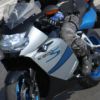
 Follow
4.4K
Follow
4.4K



